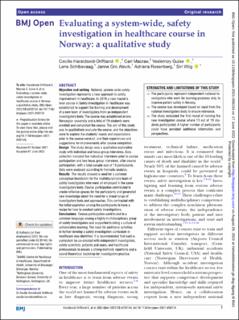| dc.contributor.author | Haraldseid-Driftland, Cecilie | |
| dc.contributor.author | Macrae, Carl James | |
| dc.contributor.author | Guise, Veslemøy | |
| dc.contributor.author | Schibevaag, Lene | |
| dc.contributor.author | Alsvik, Janne Gro | |
| dc.contributor.author | Rosenberg, Adriana | |
| dc.contributor.author | Wiig, Siri | |
| dc.date.accessioned | 2023-03-22T09:59:57Z | |
| dc.date.available | 2023-03-22T09:59:57Z | |
| dc.date.created | 2022-08-28T15:53:27Z | |
| dc.date.issued | 2022 | |
| dc.identifier.citation | Haraldseid-Driftland, C., Macrae, C., Guise, V., Schibevaag, L., Alsvik, J. G., Rosenberg, A., & Wiig, S. (2022). Evaluating a system-wide, safety investigation in healthcare course in Norway: a qualitative study. BMJ open, 12(6), e058134. | en_US |
| dc.identifier.issn | 2044-6055 | |
| dc.identifier.uri | https://hdl.handle.net/11250/3059765 | |
| dc.description.abstract | Abstract
Objective and setting National, system-wide safety investigation represents a new approach to safety improvement in healthcare. In 2019, a new master’s level course in Safety Investigation in Healthcare was established to support the training and development of a new team of investigators from an independent investigatory body. The course was established at one Norwegian university and a total of 19 students were enrolled and completed the course. The aim of this study was to qualitatively evaluate the course, and the objectives were to explore the students’ needs and expectations prior to the course conduct, and their experiences and suggestions for improvements after course completion.
Design The study design was a qualitative explorative study with individual and focus group interviews. Data collection included five individual interviews prior to course participation and two focus group interviews, after course participation, with a total sample size of 13 participants. Data were analysed according to thematic analysis.
Results The results showed a need for a common conceptual foundation for the multidisciplinary team of safety investigators who were all employed in the same investigatory body. Course participation contributed to create reflexive spaces for the participants and generated new knowledge about the need for a broad range of investigatory tools and approaches. This contrasted with the initial aspiration among the participants to have a recipe for how to conduct safety investigations.
Conclusions Course participation contributed to a common language among a highly multidisciplinary group of safety investigators and supported building a culture of collaborative learning. The need for additional activities to further develop a safety investigation curriculum in healthcare was identified. It is recommended that such a curriculum be co-created with independent investigators, safety scientists, patients and users, and healthcare professionals to ensure a strong methods repertoire and a sound theoretical backdrop for investigatory practice. | en_US |
| dc.language.iso | eng | en_US |
| dc.publisher | BMJ Publishing Group | en_US |
| dc.rights | Navngivelse 4.0 Internasjonal | * |
| dc.rights.uri | http://creativecommons.org/licenses/by/4.0/deed.no | * |
| dc.title | Evaluating a system-wide, safety investigation in healthcare course in Norway: a qualitative study. | en_US |
| dc.type | Peer reviewed | en_US |
| dc.type | Journal article | en_US |
| dc.description.version | publishedVersion | en_US |
| dc.rights.holder | The author | en_US |
| dc.subject.nsi | VDP::Medisinske Fag: 700 | en_US |
| dc.source.volume | 12 | en_US |
| dc.source.journal | BMJ Open | en_US |
| dc.source.issue | 6 | en_US |
| dc.identifier.doi | 10.1136/bmjopen-2021-058134 | |
| dc.identifier.cristin | 2046493 | |
| dc.relation.project | SHARE - Centre for Resilience in Healthcare: 5091 | en_US |
| cristin.ispublished | true | |
| cristin.fulltext | original | |
| cristin.qualitycode | 1 | |

